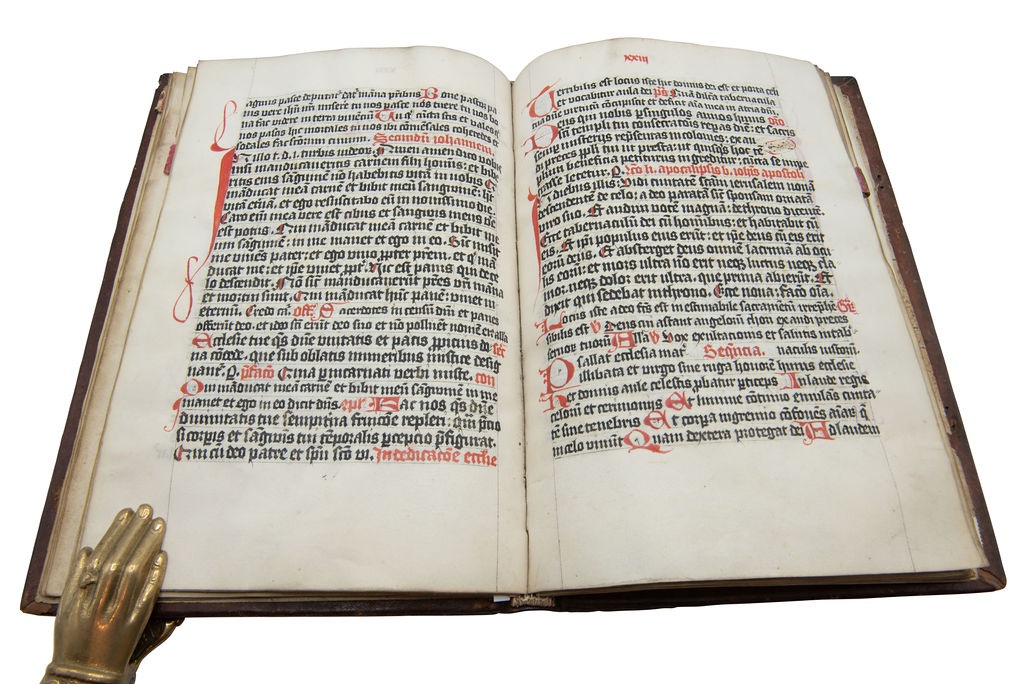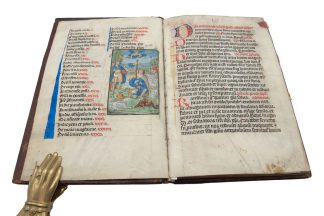Missal, illuminated manuscript on vellum.
A DUNN-GOLDSCHMIDT MS.
Missal, illuminated manuscript on vellum.
Germany (probably Bavaria, perhaps Nuremberg), dated 1478£28,500.00
Folio, 300x210mm, 52 leaves (plus paper endleaves), complete, collation: i-vi8, vii4, with catchwords, contemporary foliation in red or black at head of rectos (but skipping 3 blank leaves between two principal texts within the volume), text in single column, 27 lines per page in a good angular late medieval German bookhand, rubrics in bright red, capitals touched in red, 2-line initials in red, some with penwork decoration or baubles suspended within their bodies, larger initials in variegated red and blue with ornate penwork infill and surrounds. Two printed and hand-coloured miniatures attached to leaves at beginning of main text sections (and remnants of paper revealing another once laid down on more blank space), one large miniature on last leaf (once stuck down to previous leaf with large areas of pigment as offset on facing page), a few textual additions in margins, bottom of last two leaves cut awa apparently without loss (replaced with text), cockling to a few leaves, else good. Handsome contemporary tooled deerskin (with concentric rectangles of foliage, birds, shrubs sprouting from three square blocks), marks left from metalwork bosses at centre and corners of boards, remnant of two ties at outer edge, small amount of worm damage, spine professionally rebacked.
A fine German liturgical volume with an impressively detailed provenance, perhaps containing a miniature of an actual service in the Sebalduskirche in Nuremberg and showing Emperor Maximilian I in attendance
Provenance:
- Written and illuminated for use in the Chapel of St. Sebald, in an unspecified German church of the same dedication, perhaps the celebrated Sebalduskirche in Nuremberg (he was the patron saint of the city), during the office there of Johannes Viegel: parallel Latin and German inscriptions at head and foot of paper pastedown, both dated 1478. This same year added at end of text as well in Arabic numerals. In the sixteenth century, prayers for the priests and founders of the church were added to previously blank space at the very end of the volume.
- Smudged early nineteenth-century armorial ink stamp to first endleaf (most probably English).
- George Dunn (1865-1912), Woolley Hall, near Maidenhead: his bookplate at foot of pastedown and pencil initials and notes on facing page recording he acquired it in January 1903; sold in his sale, Sotheby’s, 11 February 1913, lot 577.
- Ernst Philip Goldschmidt (1887-1954), Viennese-born London bookdealer; this from his formidable private collection of fine early bindings: his gilt-tooled leather bookplate in centre of pastedown with “Ex libris E. PH. G.”. On him see the obituary by R.O. Dougan in The Library, 5th series, 9:2 (1954), pp. 75-84.
Text:
The volume comprises: a contents list, directing the readers to the various masses; the Missal itself with the Sanctoral and Temporal interspersed; the Canon of the Mass (fol. xl), followed by prayers to SS. Nicholas, Sebald and other readings.
Decoration:
A few decades following the production of this fine volume, at least four devotional images were added. A printed and hand-coloured miniature of the Annunciation to the Shepherds was added, partly over an inscription, in otherwise blank space at the end of the contents list. At the same time, another printed and hand-coloured miniature of near identical proportions, with the Annunciation to the Virgin, was added to blank space at the foot of recto fol. xxvi. Here text shining through the cutting, visible in the tiled floor before the Virgin and angel, allows us to see that these cuttings were both from a sixteenth-century printed devotional volume in Latin. Traces of paper and glue on the reverse show that a third image of equal dimensions and most likely from the same series once was pasted here facing the Canon of the Mass, but since removed. Such additions of devotional print material to manuscripts, particularly those used in prayers or the Mass, is common (see among many other works discussing this: K. Rudy, Image, Knife and Gluepot: Early Assemblage in Manuscript and Print, 2019).
However, what is far less common is that the final vellum endleaf here, immediately following the end of the text, was used, most probably in the first half of the sixteenth-century, for a large miniature of the Mass. In this a bishop, crowned and holding a crosier, in the middle foreground, is flanked by choristers who sing, as well as a priest who carries a gold cross while a boy carries a candle. Above them a crowned emperor is seated, looking directly out at the viewer and holding a long golden sceptre, his throne placed next to a richly decorated altar. Unfortunately, the leaf that this richly painted image was painted on seems to have suffered from damp interacting with the paint and adhered to blank space of the last leaf of the main codex, obscuring it and resulting in the image’s survival in parts both on the leaf on which it was painted and as offset on the facing leaf. The presence of a king here is startling, and it is to be wondered if this miniature represents an actual event, at which the painter (and this volume) were present. If the identification of the original home of this book as the Sebalduskirche in Nuremberg can be upheld, it is worth noting that institution was particularly close to the court of Emperor Maximilian I (reigned 1508-1519), and the provost of the Sebalduskirche, Melchior Pfinzing, acted as imperial secretary to Maximilian. This may well be a painting, from life, of an actual event attended by Emperor Maximilian I.
In stock








